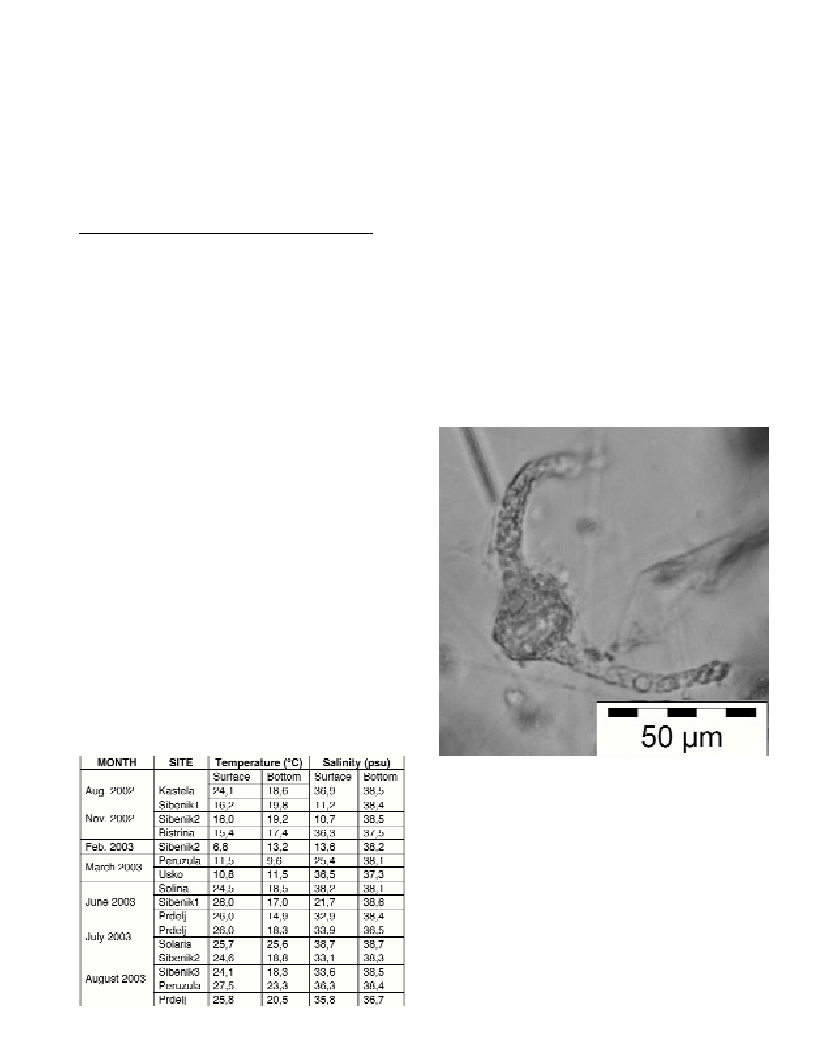PSELIODINIUM VAUBANII AN ORGANISM INTRODUCED
INTO THE ADRIATIC SEA BY BALLAST WATERS?
Sanda Skejic, ivana Nincevic-Gladan* and Ivona Marasovic
Institute of Oceanography and Fisheries, Split, Croatia
Abstract
The dino?agellate Pseliodinium vaubaniiwas first recorded from the Adriatic Sea in the vicinity of the River Po estuary, in 1978.
Subsequently it was recorded from a number of bays and estuaries along the eastern Adriatic coast. It is assumed that Pseliodinium
vaubaniiwas introduced into the Adriatic Sea with ballast waters. Even though the studies of Jacques and Soyer (2) showed this species
to occur under vertically stable conditions of the water column, we recorded it under conditions of markedly non-homogeneous water
column.
Keywords: Pseliodinium vaubanii, Adriatic, ballast waters
Rapp. Comm. int. Mer Médit., 37,2004
440
Material and methods
The phytoplankton communities near shellfish farms along the
eastern Adriatic coast were analysed over one year (August 2002
through August 2003). The samples were collected from surface and
bottom layers by Niskin bottles and plankton net (mesh size 20
µ
m)
at monthly intervals. The temperature and salinity were measured by
YSI-63 CTD sonde. The phytoplankton community was identified
using Olympus IX 50 inverted microscope (3). Pseliodinium vaubanii
Was common in our samples. We analysed the environmental
conditions under which this species occurs.
Introduction
Pseliodinium vaubaniiis first described by Sournia (4) from Nosy-
Be, Madagascar. It was first recoded in the Mediterranean in the Gulf
of Lion (2). In the Adriatic Sea the species was first recorded from the
vicinity of the Po estuary in the northwestern Adriatic (the largest
number of ships from all over the world take this route), and
subsequently from theibenik harbour in the River Krka estuary,
from Ploce harbour near the River Neretva estuary and fromKatela
Bay near the Jadro River estuary (1).
Results and discussion
Even though the species is widely distributed over all the Adriatic
coastal waters, its abundance is markedly low everywhere.
The phytoplankton of the Adriatic Sea, particularly of its northern
and central parts, has been well studied. Therefore it could hardly be
assumed that a conspicuous species such as Pseliodinium vaubanii
could be overlooked. Because P. vaubaniiwas reported from
harbours, with an increased eutrophication level, due primarily to
river run-offs and human activities, we assume it is an alien species.
It is known to occur at the bottom of homogenous water column, with
salinities 37.65 to 38.20 psu, and assuming that temperature below
15°C could be a limiting factor (2).
Our records show that P. vaubanii may occur in markedly non-
homogeneous water column, even though all the records refer to
bottom layers with considerably more stable conditions. As to the
salinity range, our results mostly agree with those of Jacques and
Soyer, even though both slightly higher and slightly lower salinities
were recorded on several occasions (Tab 1), however the species may
have a considerably broader temperature range. On several occasions
the temperature was much lower than 15°C (Tab 1), which may be
indicative of the fact that salinity is more crucial for this species than
temperature. This has also been confirmed by the fact that,
irrespective of temperature, this organism, almost as a rule, occurs in
bottom layers which have typically martime salinity, as compared to
the brackish surface layers.
Pseliodinium vaubanii seems to prefer eutrophic environments,
having settled in the eutrophic eastern Adriatic coast, regadless of
whether the eutrophication is of natural or anthropogenic origin
(shellfish farms and harbours).
References
1-Marasovic I., 1983. Records of new phytoplynkton species in the
Adriatic. Notes No 52. : 1-6.
2-Jacques G., and Soyer M., 1977. New observations on Pseliodinium
vaubanii(Sournia) a free planktonic dino?agellatae. Vie Milieu, A. 27 (1):
83- 90.
3-Utermöhl H., 1958. Zur Vervollkommnung der quantitativen
Phytoplankton Methodik. Mitt. int. Ver. Limnol., 9: 1-38.
4-Sournia A., 1973. Une période de poussées phytoplanctoniques près de
Nosy-Be (Madagascar) en 1971.I. Espèces rares ou nouvelles du
phytoplancton. Cah. ORSTOM,sér. Océanogr.,10 (2): 151-159.
Table 1. Temperature and salinity values at the investigated stations.

